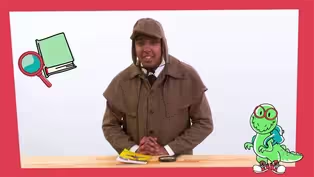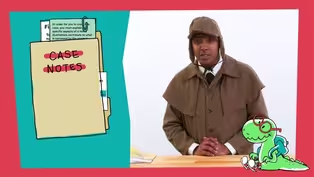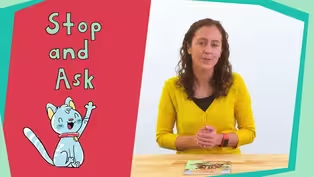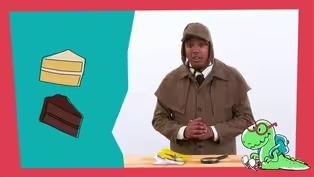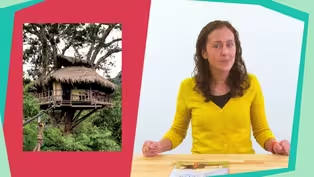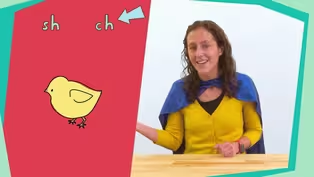
Episode 2 | Literacy Lessons
2/2/2021 | 28m 46sVideo has Closed Captions
Literacy lessons for early learners, led by NC teachers.
The first lesson is aimed at 3rd graders and teaches them how to identify vocabulary in text to aid reading comprehension. The second lesson (aimed at 1st-2nd graders) helps learners understand that letters make sounds and those sounds work together to make words. Classroom Connection is your At-Home Learning companion where children love to learn. All lessons are led by NC educators.
Problems playing video? | Closed Captioning Feedback
Problems playing video? | Closed Captioning Feedback
At-Home Learning Presents: Classroom Connection is a local public television program presented by PBS NC

Episode 2 | Literacy Lessons
2/2/2021 | 28m 46sVideo has Closed Captions
The first lesson is aimed at 3rd graders and teaches them how to identify vocabulary in text to aid reading comprehension. The second lesson (aimed at 1st-2nd graders) helps learners understand that letters make sounds and those sounds work together to make words. Classroom Connection is your At-Home Learning companion where children love to learn. All lessons are led by NC educators.
Problems playing video? | Closed Captioning Feedback
How to Watch At-Home Learning Presents: Classroom Connection
At-Home Learning Presents: Classroom Connection is available to stream on pbs.org and the free PBS App, available on iPhone, Apple TV, Android TV, Android smartphones, Amazon Fire TV, Amazon Fire Tablet, Roku, Samsung Smart TV, and Vizio.
Providing Support for PBS.org
Learn Moreabout PBS online sponsorshipMore from This Collection
Video has Closed Captions
Literacy lessons for early learners, led by NC teachers. (28m 46s)
Video has Closed Captions
Literacy lessons for early learners, led by NC teachers. (28m 46s)
Video has Closed Captions
Literacy lessons for early learners, led by NC teachers. (28m 45s)
Video has Closed Captions
Literacy lessons for early learners, led by NC teachers. (28m 45s)
Video has Closed Captions
Literacy lessons for early learners, led by NC teachers. (28m 46s)
Video has Closed Captions
Literacy lessons for early learners, led by NC teachers. (28m 46s)
Video has Closed Captions
Literacy lessons for early learners, led by NC teachers. (28m 45s)
Video has Closed Captions
Short Description: Literacy lessons for early learners, led by NC teachers. (28m 45s)
Video has Closed Captions
Literacy lessons for early learners, led by NC teachers. (28m 45s)
Video has Closed Captions
Literacy lessons for early learners, led by NC teachers. (28m 45s)
Video has Closed Captions
Literacy lessons for early learners, led by NC teachers. (28m 45s)
Video has Closed Captions
Literacy lessons for early learners, led by NC teachers. (28m 45s)
Providing Support for PBS.org
Learn Moreabout PBS online sponsorship[cheerful upbeat music] ♪ - Hi, friends.
Welcome to another awesome day of Classroom Connection.
I'm Mr. R, and I'm so glad to see you today.
Did you know that this space right here, this space right here is magical?
Yeah, it's true.
And you know why?
Because this is where learning happens, and learning is the most magical thing ever.
I love learning new things.
Do you?
I know you do.
Today is going to be so much fun.
We're going to learn about reading as well as arts and science, but mostly we're going to have some fun.
So let's jump in.
- Hey, everyone.
My name is Ms. Shannon, and I'm so happy you're here to learn with me today.
Have you ever looked at the sun in the sky or felt it's warmth on your body and wondered exactly what it's like?
Whoa, that's hot!
How does the sun actually work?
Today we'll be reading part of this book called "Sun!
One in a Billion" to answer some of our questions.
The way this story is written by the author Stacy McAnulty is really unique because it blends elements from two different genres or types of texts.
We'll learn more about this as we dig into our book.
As we read today, we'll need to be word detectives and pay close attention to find the most important words that will help us understand our topic, the sun, more deeply.
We'll be using strategies from our word detectives toolkit that can help us find important words in any text we read.
Let's get started, word detectives.
As I read, watch me find the words in the text that will help me understand the information this book gives us about the sun.
[gentle upbeat music] "Once upon a time, about 4.6 billion years ago, a magnificent and important star was born.
And that magnificent and important star was me, your Sun with a capital S." Now, watch me figure out which words seemed really important so far to help me understand this text.
You'll be doing it yourself soon, so watch carefully.
I'm noticing that the author repeated the words magnificent and important on the first two pages.
So she must really want me to remember that the sun is both of those things.
When you see words repeat, that's a signal that they're important.
That's in our word detectives toolkit.
[bright upbeat music] The author included those words twice because she wants us to know that the sun is magnificent, which means amazingly awesome.
And also that the sun is very important.
Speaking of important, I mentioned earlier that there's something I really want you to know about this book's genre or the category of books it belongs to.
It has facts like a non-fiction text, but it also seems like a fiction text because it pretends the sun is a living character with a personality and feelings.
So it has some elements of information and some elements of fiction.
As we read, remember that we'll find a lots of true facts about the sun, but that it isn't actually alive.
The author just wrote the book that way to make it more interesting and fun to read.
Watch me show you how to find the important vocabulary words one more time, and then you're going to help me.
"Yes, I am a star.
Star: one, a massive and luminous ball of gas full of energy.
Two, an astoundingly talented and popular performer.
I fit both definitions."
Watch and listen as I think.
The first thing I'm noticing is that the word star repeats, so it must be important.
Remember when we found that in our toolbox earlier?
When words repeat, that tells us they're important.
Stacy McAnulty included two definitions of the word star from a dictionary because she wants us to know that the sun is a star in more than one way.
When it says it fits both definitions, that means it's a star in outer space, that's the informational true part of the book that goes with the first definition, and that she's pretending it's a famous superstar that others love to watch and listen to for entertainment, like someone you may see or hear a lot in a show, movie, or song.
That's the fictional or imagined piece that goes with part two of the definition.
There are a couple of other words I'm noticing that seem really important to understanding this book: massive, which means really big, and luminous, which means really bright with lots of light.
I know those words are important because the author is using them to describe the sun, which is the topic of the entire book.
We definitely need to know what the words mean that the author uses to describe the topic, so let's get that strategy out of our word detective toolkit.
[bright upbeat music] Now we know two strategies that help us decide which words are important: repeated words and words that describe the topic of our book.
Since the sun is massive and luminous, we know that it's a big, bright ball of light, gas, and energy.
Now that you've watched me do it, I want you to be word detectives and use the strategies from our toolkit to try and find the important words on these pages.
Here we go.
[bright upbeat music] "The Milky Way galaxy has over 100 billion stars.
That makes me one in a billion or, um, one in 100 billion.
Me.
I'm not the biggest, so what?
Not the brightest, who cares?
Not the oldest, whatever.
But I am the most important, at least to you Earthlings."
Did you find one?
[bright upbeat music] Great thinking.
Billion repeated three times.
So that's a definite signal that it's a word we should pay attention to.
Finding words that repeat is one of the strategies in our word detectives toolkit.
The author really wants us to know that there are a ton of stars.
I also wanna show you another strategy from our toolkit that helps us find keywords, names.
[bright upbeat music] We can see here that the Milky Way is capitalized because it's the name of a galaxy.
Milky Way galaxy is important to know so we can better understand our topic, the sun.
We can figure out the meaning of galaxy by using the words and picture together.
It says a galaxy has billions of stars, and then it shows us where the sun is in that big galaxy.
We can tell from these words and pictures together that a galaxy is a huge group of stars and planets that are all part of one system.
And the galaxy that our planet earth and our sun are in is called the Milky Way.
Let's read on to see if we can find more important words using our strategies.
[bright upbeat music] "Can you hang out for eight minutes?
That's how long it takes my light to reach Earth.
Yep, I give you heat and light.
You're welcome.
I'm so important that Earthlings should name a special day in my honor.
We can call it Sundaaaa-oh, wait."
Hmm, as I look at our three strategies from our toolkit that help us find important words: look for repeating words, find words that describe the topic, and notice names, I'm noticing that I can use one of them to find a keyword on this page.
It's a word that's repeated from the last page we read.
Do you see it?
[bright upbeat music] Yes, Earthling.
We saw it earlier and here it is again, so it must be important.
How can we figure out what that means?
We can use the text and picture together here to figure it out.
The text says, "You Earthlings" and shows people, so Earthlings must mean people, just like us reading.
That's why it said, "You."
It was talking to us Earthlings.
And it says here that Earthlings have a named day after the sun.
And we do have a day that we call Sunday.
So that means us.
Now we know that an Earthling is a person that lives on Earth.
That includes you.
Hello, Earthling.
Before I read the next two pages, I wanna show you another strategy from our word detective toolkit that can help us find the most important words.
If a word is bold or looks different than the other words around it, you should pay attention.
[bright upbeat music] As I read the next two pages, see if you can use that strategy to find an important word.
"I'm famous for my heat and light, but I also hold our entire solar system together.
Scientists call it gravity.
What can I say?
The planets are attracted to me."
Did you find it?
[bright upbeat music] Yes, gravity stands out.
It's a different color and a little larger than the rest of the text on the page.
So that signals to us that it's really important.
The text tells us that it means a type of attraction that holds things together.
So now we have four strategies from our toolkit to help us find important words.
Look for repeating words, find words that describe the topic, notice names, and see bold print.
Let's use them to find more important words on the next page.
"And because I'm the center of our solar system, life revolves around me literally.
Look, they all go in the same direction."
And we see the sun with all the planets going around it: Neptune, Saturn, Uranus, Venus, Earth, Mars, Mercury, and Jupiter.
And it tells us how long a year is on each planet.
Were you able to find any important words using our four strategies?
[bright upbeat music] The first one I noticed is the solar system.
We saw that term on the last page and here it is again.
Since it repeats, it must be important.
The words and pictures help us understand that our solar system includes all of the planets that go around our sun.
Using the pictures and words together can help us understand the meanings of important words.
We're going to stop here for now, But before we go, let's review what we've learned.
When we find a text that provides lots of facts, we should think about which words are most important to understanding the topic.
Our topic today was the sun, and we found so many important words that helped us understand it more deeply, like magnificent, important, star, massive, luminous, billion, Milky Way, galaxy, Earthling, gravity, and solar system.
Our word detective toolkit taught us four strategies that can help us find important words: look for repeating words, find words that describe the topic, notice names, and see bold print.
You can use these with any text you read, not just this book.
See you next time when we continue to read "Sun!
One in a Billion" and think more about how to figure out what words mean.
I'll see you all and the sun again soon.
[air whooshing] - The arts have made me the person I am today because I have been able to grow as a person using art to express myself.
How do you most like to express yourself?
Let's watch this awesome video about art, and you can think of a new way to express the inner you.
- Hi, kids.
Welcome to an episode of "Paint N Sippy Cup."
I am your host, Auntie Gem, and today I am going to be painting an apple.
To go along with my apple, I have apple juice in my sippy cup.
What kind of juice are you sipping on today?
I will be using this canvas to paint on, but also you can paint on anything else you may have in your house, including paper or cardboard.
The paint colors I'll be using are red, yellow, green, and black, but you can use whatever colors you choose.
[slow upbeat music] I also have a couple of paint brushes which include kind of a wider one, kind of a medium one, and a smaller one.
And of course I have a little water to go with my paint.
I'm going to start off with our apple by drawing it.
[slow upbeat music] So I have my apple drawn.
First thing we're gonna do is start on the background.
[slow upbeat music] So now that we have our background painted, I will begin on the apple.
[slow upbeat music] And just remember, your apple can be whatever color you want.
If you want a pink apple, make it pink.
If you want a blue apple, make it blue.
If you want a green apple, make it green.
I'm just so happened to be making a red apple today.
[slow upbeat music] I'm also gonna use this black to help outline my apple to make it really pop out.
[slow upbeat music] I'm also gonna make sure that I put my name on it before I finish so that people don't forget that Auntie Gem made it.
So I'll put my name in the comer.
And just remember that you can do all kind of things to make this painting unique.
You can add eyes and a smiley face and make it a happy apple.
You can add dots and zigzags into the background.
So there you have it, kids.
We have a very simple apple here.
Just remember that you can add whatever want to your art to make it unique.
You don't have to paint like me.
You can paint like you.
This is just one way to do it.
Thanks for joining me on another episode of "Paint N Sippy Cup."
I can't wait to see what you create, and I'll see you next time.
[bright music] - Hello, readers.
My name is Ms. Gary, and I'm so excited to be learning with you today.
Before we get started with our lesson, let's say hello with our welcome song.
[cat meows] ♪ Hello readers ♪ ♪ Hello readers ♪ ♪ How are you ♪ ♪ How are you ♪ ♪ I'm so glad to see you ♪ ♪ I'm so glad to teach you ♪ ♪ Hello, you, you and you ♪ Well, readers, have you ever wondered how we know what sounds to say when we are reading words?
Hmm.
When I'm reading words or hearing words, how do I know what sounds the letters make?
Or what sounds are in the words?
How do I know what letters are used to make those sounds?
We know what words are and what sounds letters make.
Because as a reader, our brains are using our knowledge of letter sounds to determine what sounds we hear in words.
This is what helps us read and write words.
For example, when I read the word bat, my brain tells me the word sounds like this, buh ah tuh, because the word bat is spelled B-A-T.
So before we can read words, we have to know what the sounds say.
So let's see and say the letter names and sounds of the letters on these cards together.
[gentle upbeat music] This is the letter B.
The letter B makes the sound buh.
Can you say buh?
Good, readers.
[gentle upbeat music] Look at this letter.
This is the letter F. The letter F makes the sound fuh.
Can you say fuh?
Great job, readers.
[gentle upbeat music] Do you know what this letter is?
That's right.
This is the letter G. This makes the guh sound.
And sometimes it can make the sound juh also.
[gentle upbeat music] This is the letter L. The letter L makes the sound ul.
Can you say ul?
Great job.
Let's look at this letter.
This is the letter O.
This is a vowel and it can say the sound ah or oo.
Can you say that?
[gentle upbeat music] Here's our next letter.
[gentle upbeat music] This is the letter U.
This is a vowel that says the sound uh or u.
[gentle upbeat music] Here's our next letter, This is the letter P. This makes the sound puh.
Can you say puh like the letter P?
Great job.
And our last letter is the letter X.
The letter X makes the sound ks.
Can you say ks like the letter X?
Awesome work, readers.
To keep practicing these letter sounds, you can make letter cards too.
Just ask your responsible adult to help you gather some index cards and write the letters, and then practice saying the letter names and sounds with you.
You can also practice on your own too, and this will help you get even better at knowing the letter sounds when you hear or read them.
In addition to knowing our letter sounds, during each lesson, we're going to learn some words.
These words have a special name called heart words.
We call these words heart words because we practice reading them so that we'll know them by heart or so that we won't have to sound them out.
So let's look at this word.
[gentle upbeat music] This is the word what.
Can you say what?
Good.
Not let's spell it.
W-H-A-T. Say it one more time.
What.
Now let's put this heart word in our minds and keep it there for when we see it in a book or write it on our paper.
Here comes our next one.
Look at this word.
This is the word said.
Can you say said?
Now let's spell it.
S-A-I-D, said.
Let's say it one more time.
Good.
Now let's put this heart word in our mind and keep it there so when we see it in a book or write it on paper.
So we've practiced to heart words, readers.
So we have one more to go today.
Let's look at this word.
This is the word the.
Can you say the?
Good.
The is spelled T-H-E. Now let's put this heart word in our mind also and keep it there for when we see it in a book or write it on paper.
Great heart word practicing, readers.
Now let's move on to our focus for today.
In today's lesson, we're going to learn how to identify sounds we hear in the beginning, middle, and ends of words.
We're also going to break those sounds apart, and then blend them back together to read the word that we hear.
So let's get started.
[gentle chime] I'm going to show you a picture and you're going to tell me what it is.
[gentle upbeat music] What do you see?
That's right.
It's a bug.
What letter sounds do you hear in the word bug?
Can you tell me the first or beginning sound in the word bug?
Yes it's buh.
[gentle upbeat music] Can you say buh like in the beginning?
Now, what sound do you hear in the middle of bug?
Uh.
I hear the u.
Say the uh sound in the word bug.
Now can you tell me the last or final sound you hear in the word bug?
Right, readers.
I heard the G make the guh sound in the word bug.
So let's say this word: bug.
Let's say the sounds we hear.
You've ready?
Buh, uh, guh.
Bug!
Let's say it one more time.
Bug, that's the word bug.
I'm gonna take down the word bug and show you our next picture.
Look at this picture.
What do you see?
Yes, readers.
This is a plug.
Let's see what sounds we hear in the word plug.
The first sound we hear in the word plug is puh.
That's right.
It's the letter P, and it makes the sound puh.
Can you say puh?
Good.
What about the next sound in the word plug?
Yes.
It's the ul sound.
Good job.
What about the sound after?
Right, it's the u and it makes the sound uh.
Can you say uh?
And what's the last sound you hear in the word plug?
Great job.
It's the letter G and it makes the guh sound.
So now let's blend those individual sounds together.
Are you ready?
Puh, ul, uh, guh.
Plug!
Can you say it one more time?
Plug.
This is the word plug.
Now I'm gonna show you another picture.
[gentle upbeat music] What do you see in this picture, readers?
Good, this is a fox.
What's the beginning sound in the word fox?
Right, it's the fuh sound.
Can you say fuh like in fox?
Good.
That's the sound the letter F makes in fox.
What about our next sound?
Yeah, I heard you say oo.
The letter O makes the oo sound.
[gentle upbeat music] What about our final sound in the word fox?
Right.
Our X makes the ks sound.
Can you make the ks sound like the letter X?
Great job.
So now let's blend all of our sounds together and read our whole word fox.
Fuh oo ks.
Fox.
Great job.
Those sounds work together in this word to make the word fox.
Okay, readers.
Let's get ready.
Now that we've practiced identifying letter sounds and blending them back together into words, I wanna teach you a strategy for practicing this skill on your own with new words.
So let's use our word fox.
I can tap the sounds I hear in the word fox by using my fingers.
Fuh oo ks and blend them together, fox.
Can you try it on your own?
Fuh oo ks.
Fox.
Great job.
So now we're gonna practice on our own.
[gentle upbeat music] What picture do you see here, readers?
Can you tap out the sounds that you hear in the word box?
Great.
I heard you tap out the word box like this.
Buh oo ks.
Great job.
You tapped out the sounds the word box.
Buh oo ks.
Box.
Now look at this picture.
Can you tell me what this is?
It's a dog, but it's a special kind of dog.
This is a pug.
Can you tap out the sounds you hear in the word pug?
Let's hear.
Great job.
Did you tap out puh uh guh, pug?
Good, you tapped out the sounds in the word pug.
Well, readers, that's the end of our lesson for today.
Thank you all for joining me ss we learned about how to identify the sounds we hear in the words and blend those sounds together to read the word.
Remember to practice this skill when you're reading or writing your words.
I'll see you next time, readers.
[cat meows] - Wow, wow, wow, wow!
What a day so far?
So much great learning going on.
Next, we're going to watch a video about science that I know you'll love.
- [Narrator] Life is complicated.
There are a ton of different parts doing a ton of different things, but those parts and things are all referencing a set of instructions that are unique to each organism.
And those instructions are DNA.
This little helix is a super special molecule that's found in the nucleus of every cell in a living organism, from the more complicated to the less complicated.
DNA is a long coiled set of basic letters that when organized into sentences and chapters, make the instruction manual for an organism.
All by itself, the DNA doesn't do much, but when chemicals and proteins in the cell read the DNA, they can tell other chemicals and proteins how to build whatever parts need building.
And those parts that come by the millions are the building blocks that make the cells, tissues, and organs of each living thing.
You've got to admit, that's a lot of potential for a single molecule.
[bright upbeat music] - Ah, shooop!
That's all the time we have for today, y'all, but I'll see you right back here in no time.
I see no thumbs up.
Yo, I'll see you soon.
Peace, love, and learning, super learners.
Bye.
[bright upbeat music] ♪
Support for PBS provided by:
At-Home Learning Presents: Classroom Connection is a local public television program presented by PBS NC

